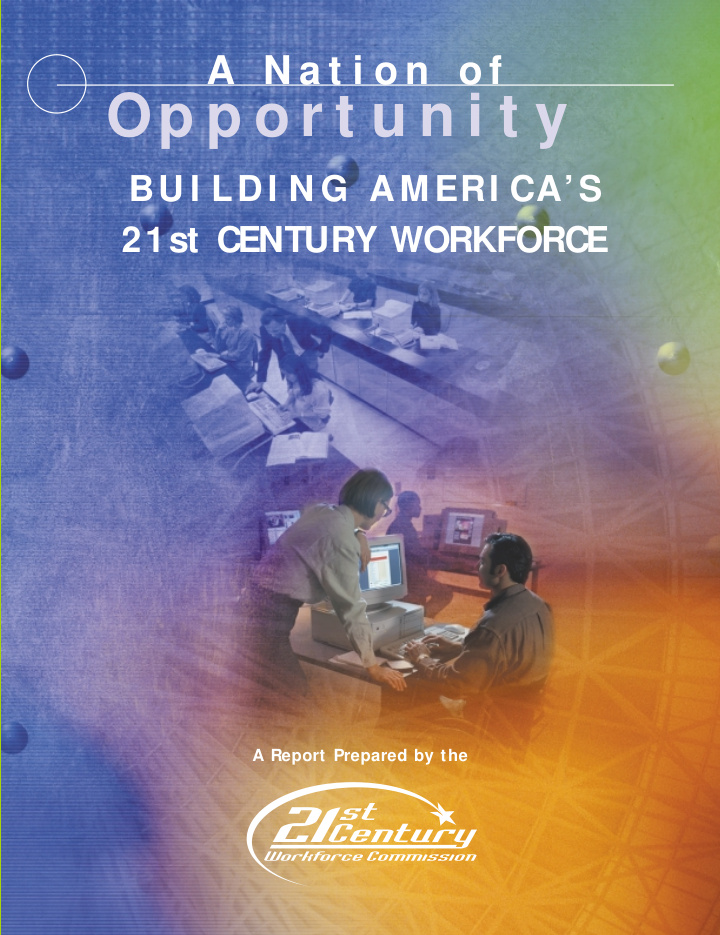



A N a t i o n o f Op p o r t u n i t y BU I LDI N G AM ERI CA’S 21st CENTURY WORKFORCE A Report Prepared by the
A N o t e t o To d a y ’s Wo r k i n g A m e r i ca n Dear friend, This report echoes the message that every American worker needs to acquire higher levels of education and training to succeed in today’s and tomorrow’s economy. As the digital revolution unfolds, we realize that job security cannot be dependent upon a corporate identity. Job security rests on the skills and knowledge you carry with you — your “employability.” That is why we hope you see it in your best interest to take an active management role over your own skills and education. Of course, you will need to make sure you have the solid reading, math, learning, and thinking skills demanded by 21st Century Literacy. You may also find it necessary to upgrade specific technical skills based on your personal likes, aptitudes, and job market opportunities. You can tap into a wide variety of resources to develop your skills. Community colleges, local One-Stop Career Centers, and community-based centers can help you access career planning tools, as well as the basic skills, technology skills, and other educational courses you will need. As you begin this process of education and training, remember that acquiring new job skills is not a once-in-a-career event. As technology continues to change and evolve, every one of us needs to make learning a lifetime habit. Rapid technological change has made today’s world very demanding. Yet, these changes also offer us enormous opportunities for personal growth, fulfillment, and success — the ideal of America as the “Nation of Opportunity.” Sincerely, The Members of the 21st Century Workforce Commission, June 2000
BU I L D I N G A M ERI CA’ S 2 1 st Ce n t u r y Wo r k f o r ce Ta b l e o f Co n t e n t s Executive Summary: .......................................................................4 I . I ntroduction .................................................................8 Dynamics of the 21st Century Information Economy .............................................................9 The Charge of the 21st Century Workforce Commission ..........................................................9 The Deepening Impact of T echnology .................................................................................9 The Shortage of Information T echnology Workers / The Skills-Gap .........................................10 America’s Changing Face .................................................................................................11 The Mandate for 21st Century Literacy ..............................................................................13 1 I I . Understanding I T Job Skills and Market Demand ..................................................14 What Exactly is an IT Worker? ..........................................................................................15 Core IT Professions.........................................................................................................15 IT Skills Clusters ............................................................................................................15 Which IT Jobs are in Demand? .........................................................................................17 I I I . Keys to Success for Building the 21st Century Workforce ..............................20 Key to Success 1: Building 21st Century Literacy.........................................................22 The Relevance of 21st Century Literacy to Developing the IT Workforce .................................23 Challenges to Building 21st Century Literacy .....................................................................23 Trends and Practices in Building 21st Century Literacy ........................................................26 Leadership Response to Building 21st Century Literacy........................................................26 Key to Success 2: Exercising Leadership Through Partnerships ......................................28 Relevance of Exercising Leadership Through Partnerships to Developing the IT Workforce ......................................................................28 Challenges to Exercising Leadership Through Partnerships....................................................29
Trends and Practices in Exercising Leadership Through Partnerships ......................................30 Leadership Response to Exercising Leadership Through Partnerships ......................................31 Key to Success 3: Forming Learning Linkages for Youth................................................34 The Relevance of Forming Learning Linkages for Y outh to Developing the IT Workforce ...............................................................................34 Challenges to Forming Learning Linkages for Y outh.............................................................35 Trends and Practices in Forming Learning Linkages for Y outh ...............................................36 Leadership Response to Forming Learning Linkages for Y outh ...............................................39 Key to Success 4: I dentifying Pathways into I T Jobs ....................................................40 Relevance of Identifying Pathways into IT Jobs to Developing the IT Workforce.................................................................................40 Challenges to Identifying Pathways into IT Jobs.................................................................42 Trends and Practices in Identifying Pathways into IT Jobs ...................................................44 Leadership Response to Identifying Pathways into IT Jobs...................................................45 Key to Success 5: I ncreasing Acquisition of I T Skills....................................................46 Relevance of Increasing Acquisition of IT Skills to Developing the IT Workforce ........................................................................47 2 Challenges to Increasing Acquisition of IT Skills.................................................................47 Trends and Practices in Increasing Acquisition of IT Skills ...................................................51 Leadership Response to Increasing Acquisition of IT Skills ...................................................53 Key to Success 6: Expanding Continuous Learning .......................................................54 Relevance of Expanding Continuous Learning to Developing the IT Workforce ...........................................................................54 Challenges to Expanding Continuous Learning ....................................................................55 Trends and Practices in Expanding Continuous Learning .......................................................57 Leadership Response to Expanding Continuous Learning ......................................................60 Key to Success 7: Shaping a Flexible I mmigration Policy .............................................62 Relevance of Shaping a Flexible Immigration Policy to Developing the IT Workforce ................62 Challenges to Shaping a Flexible Immigration Policy ...........................................................62 Trends and Practices in Shaping a Flexible Immigration Policy..............................................63 Leadership Response to Shaping Flexible Immigration Policy ................................................63 Key to Success 8: Raising Student Achievement ...........................................................64 Relevance of Raising Student Achievement to Developing the IT Workforce ............................64 A N a t i o n o f Op p o r t u n i t y
BU I L D I N G A M ERI CA’ S 2 1 st Ce n t u r y Wo r k f o r ce Challenges to Raising Student Achievement .......................................................................65 Trends and Practices in Raising Student Achievement ..........................................................67 Leadership Response to Raising Student Achievement .........................................................69 Key to Success 9: Making Technology Access and I nternet Connectivity Universal .........72 Relevance of Making T echnology Access and Internet Connectivity Universal to Developing the IT Workforce ........................................................72 Challenges to Making T echnology Access and Internet Connectivity Universal .........................73 Trends and Practices in Making T echnology Access and Internet Connectivity Universal .............74 Leadership Response to Making T echnology Access and Internet Connectivity Universal.............76 V. Conclusion ..............................................................78 Leadership Through Partnerships: A “Uniquely American” Response .......................................79 The Commissioners.........................................................................................................81 VI . Acknowledgements ................................................82 ENDNOTES: ....................................................................................................................85 3
Exe cu t i ve Su m m a r y 4 A N a t i o n o f Op p o r t u n i t y
Recommend
More recommend